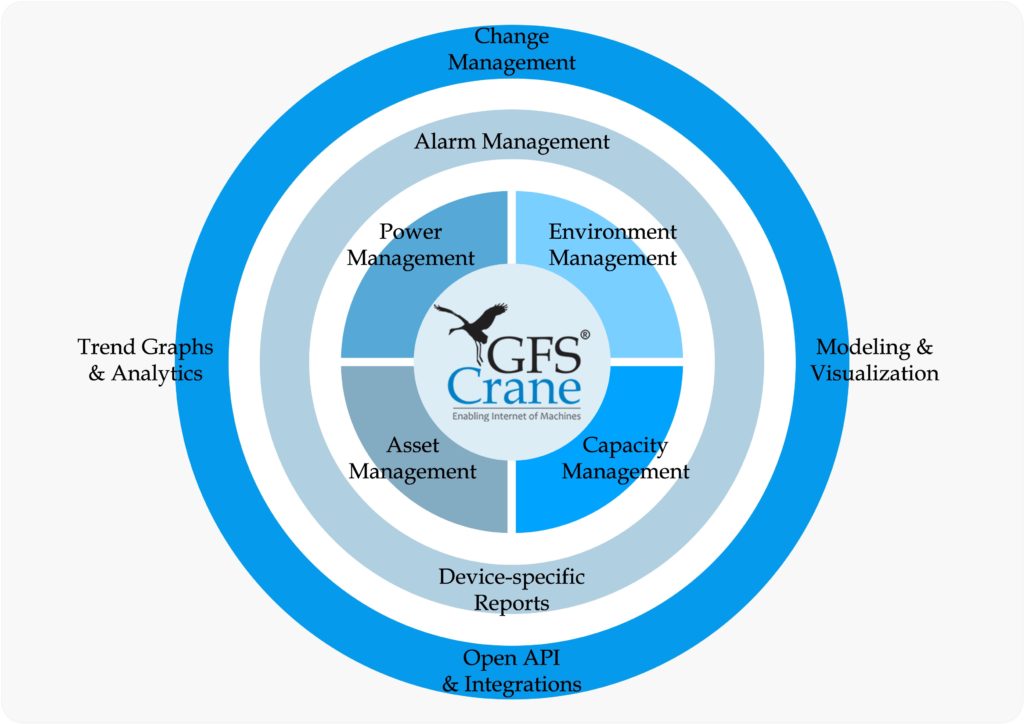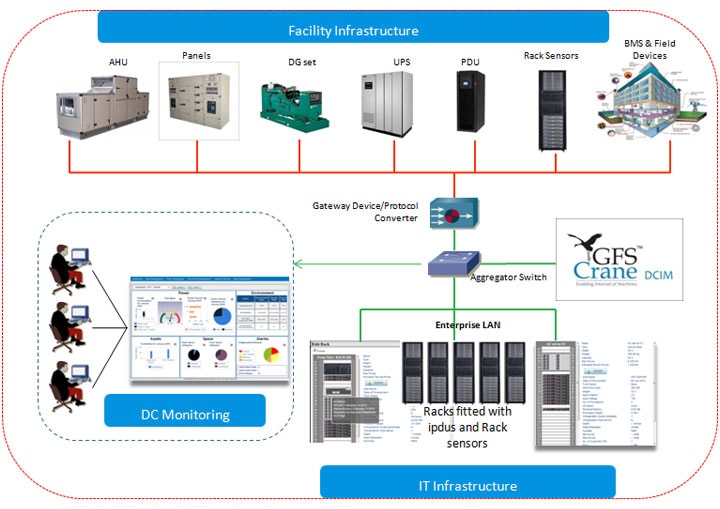GFS CRANE – Data Center Infrastructure Monitoring System
Built with modular functionality within each edition, GFS Crane DCIM provides a complete suite for Data Center Operations, Planning and Management.
The foremost responsibility of a Data Center Manager is High Availability. To achieve this, the topology of the modern Data Center has been defined by extreme redundancies. This has made the Data Center capital-intensive, complex and costly to operate. Ironically, extreme redundancies multiply the vulnerable points, as some recent high profile Data Center failures have shown.
GreenField Software’s GFS Crane® DCIM Software addresses this DC challenge: how to de-risk the Data Center while helping CFOs & CIOs control over-provisioning or wasteful capital expenditure and reduce operating costs.
Built with modular functionality within each edition, GFS Crane DCIM provides a complete suite for Data Center Operations, Planning and Management.

GFS Crane DCIM comes in two editions
The foremost responsibility of a Data Center Manager is High Availability. To achieve this, the topology of the modern Data Center has been defined by extreme redundancies. This has made the Data Center capital-intensive, complex and costly to operate. Ironically, extreme redundancies multiply the vulnerable points, as some recent high profile Data Center failures have shown.
GFS CRANE for Enterprise Data Centers attributes:
- Completeness- includes both Data Center Groups: IT Infrastructure and Facility Infrastructure
- Modular – integrated software with following Modules
- Asset Management (Core Module)
- IT Infrastructure Monitoring & Alarms
- Facility Infrastructure Monitoring & Alarms
- Power Management
- Cooling & Environment Management
- Capacity Planning
- Extensible – allows licensing only for Data Center Groups and Modules you need for now
- Scalable – meet needs of Data Centers with less than 20 Racks to those with hundreds of Racks
- Designed to manage single to multiple Data Centers from a central installation
- Cost Effective – can substitute a Building Management System as well as work in tandem with it
- Customizable – for specific customer needs:
- New KPIs, device reports and widgets on Dashboards
- Custom skins for OEM deliveries
- Rack Management System for Modular Data Centers
GFS Crane DCIM in Action

GFS Crane DCIM for Colocation Data Centers supports multi-tenancy. Besides Service Providers, this can be ideal for Enterprise Shared Services Centers catering to multiple Strategic Business Units (SBUs).
Large brownfield Data Centers are likely to have Building Management Systems (BMS) in place to monitor and send alerts from critical facility devices. In such an environment, GFS Crane DCIM integrates with BMS to:
- Enhance Internal Colo DC operations, planning and management capabilities
- Enhance customer value through secure customer portals in a multi-tenant environment.
Enhancing Internal Operations
GFS Crane DCIM will complement BMS to provide:
- Asset Inventory with:
- Location of Asset
- Ownership of Asset
- Preventive Maintenance Schedule
- OEM Library
- DC Floor Layout visualization with Racks and other facility devices in 2D and 3D showing
- Multiple floors, zones, halls and cages
- Thermal maps
- Uptime Reports for monitored devices
- Customer On-boarding/resource provisioning
- Branch Circuit or Rack Power Reporting and Energy Billing
Enhancing Customer Values
Colocation Service Providers use GFS Crane DCIM to provide Value-Added service to their customers.
GFS Crane DCIM’s Multi-tenancy allows customers to access only their data with complete security
- For DCIM-as-a-Service environment, multi customer logins is provided through GFS Crane.
- With valid credentials, customers are restricted to data only from their (or common) assets/parameters within their own DC or cage.
- Rack-wise power monitoring reports: Electrical data & reports relevant to customer A, is made available only for Racks owned by customer A.
- Visibility of reports and alarms for their own infrastructure
- Separate Customer Dashboards: Each customer will have individualized dashboard for its own set of racks.
